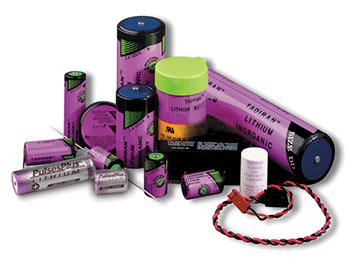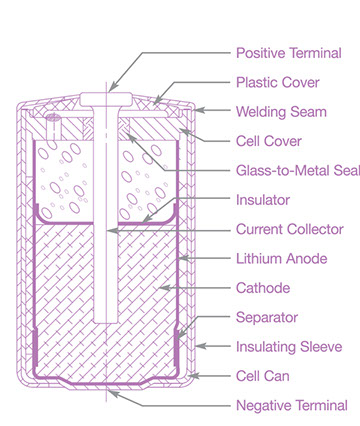Long-Life Lithium Batteries

TADIRAN Batteries: Powering Remote Wireless Devices for up to 40 years
Our Long life lithium batteries enable remote wireless devices to operate maintenance-free for decades.
Lithium chemistry remains the preferred choice for remote wireless applications due to its intrinsic negative potential, which exceeds that of all other metals. The lightest non-gaseous metal, lithium offers the highest specific energy (energy per unit weight) and energy density (energy per unit volume) of all available battery chemistries. Lithium cells are all non-aqueous, and have normal OCVs of between 2.7 and 3.6 V. The absence of water allows lithium chemistries to operate in more extreme temperatures.
While numerous lithium chemistries are available, lithium thionyl chloride (LiSOCL2) chemistry stands apart due to unique performance attributes that make it ideal for applications such as electronic toll tags, RFID, environmental monitoring, mil/aero, smart grids, automatic meter reading (AMR), wireless mesh networks, system control and data acquisition (SCADA), data loggers, measurement while drilling, oceanographic measurement, and emergency/safety equipment.
Bobbin-type construction

LiSOCL2 Long life lithium batteries are constructed two ways, using spirally wound or bobbin-type construction. Of the two alternatives, bobbin-type
LiSOCL2 cells deliver the higher energy density (1420 Wh/l) along with higher capacity, as well as the ability to withstand more extreme temperatures (-55°C to 125°C), with specialized models adaptable down to cold-chain temperatures of -80°C.
A key attribute of a bobbin-type LiSOCL2 cell is a very low annual self-discharge rate (less than 1 percent per year), which is crucial to offering Long life lithium batteries up to 40-year operating life, as the total lifetime self-discharge of the battery is often greater than the total amount of energy consumed by the device. Self-discharged is governed by the passivation effect along with the chemical composition of the electrolyte, the manufacturing processes used, as well as mechanical and environmental considerations. Self-discharge can be accelerated by high levels of impurities in the electrolyte, as well as through internal impedance, which can be controlled by blending special additives into the electrolyte.
High Pulse Applications
Numerous parameters influence the battery selection process, including:
• Energy consumed in dormant mode (the base current).
• Energy consumed during active mode (including the size, duration, and frequency of pulses).
• Storage time (self-discharge during storage diminishes capacity).
• Thermal environments (including storage and in-field operation).
• Equipment cut-off voltage (as battery capacity is exhausted, or in extreme temperatures, voltage can drop to a point too low for the device to operate).
• Battery self-discharge rate (which can be higher than the current draw from actual use).
If the wireless application involves dormant periods at elevated temperatures, alternating with periodic high current pulses, then lower transient voltage readings can result during initial battery discharge. This phenomenon, known as transient minimum voltage (TMV), affects bobbin-type LiSOCL2 batteries due to their low-rate design.
One alternative is to use PulsesPlus lithium thionyl chloride batteries that combine a standard long-life bobbin-type LiSOCL2 cell with a patented hybrid layer capacitor (HLC). The battery and HLC work in parallel, with the battery supplying long-term low-current power while the HLC supplies pulses up to 15 A, thus eliminating the voltage drop that normally occurs when a pulsed load is initially drawn.
The single-unit HLC works in the 3.6 to 3.9 V nominal range to deliver high pulses and a high safety margin, thus avoiding the balancing problems, current leakage, and bulkiness associated with supercapacitors.
When low to moderate pulses are required, Tadiran Rapid Response TRR Series batteries could offer a solution. These batteries do not require the use of an HLC but deliver high capacity and high energy density while virtually eliminating TMV and power delay issues that affect standard LiSOCL2 batteries when they are first subjected to load. TRR Series batteries use available capacity efficiently to extend battery operating life up to 15 percent in certain instances, including extreme temperatures.
Evaluating Battery Suppliers
Bobbin-type LiSOCl2 Long life lithium batteries made with high-quality materials and advanced manufacturing techniques can reduce the potential for electrolyte leakage, short circuits, and batch-to-batch inconsistency that can shorten service life.
The annual self-discharge rate can vary from less than 1 percent per year for a leading brand to as much as 2.5 percent to 3 percent per year for a lower quality product.
As a result, design engineers need to be extremely wary of battery manufacturer claims regarding low annual self-discharge at ambient temperatures, which may not be valid depending upon the size of the battery, its method of construction, or environmental considerations, as the difference of just a few microamps in annual self-discharge rate can translate into years of battery life expectancy.
To authenticate product quality and traceability back to the raw materials, potential battery suppliers should be required to submit multiple customer references along with fully documented and verifiable test results for battery pulses, low-temperature pulses, discharge, and repeatability.
Careful due diligence during the vendor selection process will ensure reliable, long-term power.
Let us know more about your application.
From research and design, to world class ISO 9001:2000 certified manufacturing and quality assurance, to a global sales and distribution network, Tadiran is ready to serve your needs with standard cells or custom battery packs.